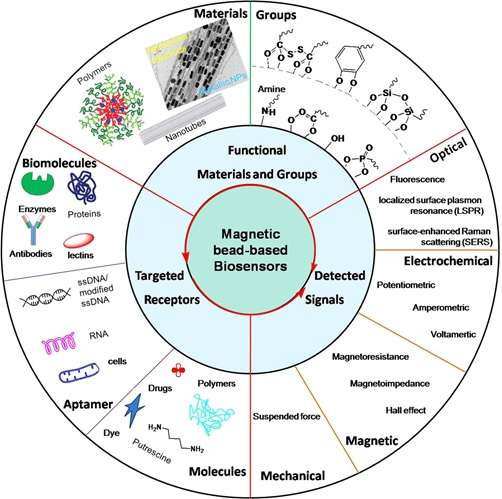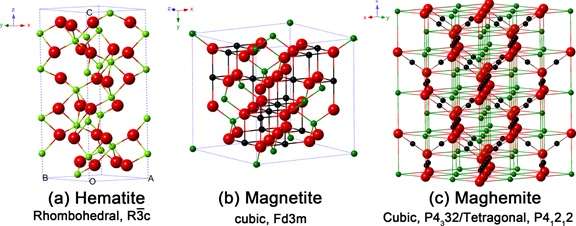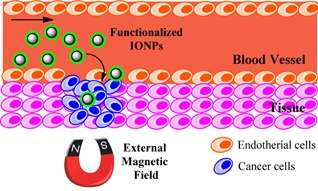Magnetic biosensor components. Credit: Science and Technology of Advanced Materials
Recent developments and research related to iron oxide nanoparticles confirm their potential in biomedical applications – such as targeted drug delivery – and the necessity for further studies.
Iron oxides are widespread in nature and can be readily synthesized in the laboratory. Among them, hematite, magnetite and maghemite nanoparticles have particularly promising properties for biomedical applications.
Researchers in China and Korea reviewed recent studies on the preparation, structure and magnetic properties of iron oxide nanoparticles (IONPs) and their corresponding applications. The review, published in the journal Science and Technology of Advanced Materials, emphasized that the size, size distribution (the relative proportions of different-sized particles in a given sample), shape and magnetic properties of IONPs affect the location and mobility of IONPs in the human body. However, having complete control over the shape and size distribution of magnetic IONPs remains a challenge.
For example, magnetic IONPs are promising for carrying cancer drugs that target specific tissues. For this to happen, they are coated with a biocompatible shell that carries a specific drug. If this "functionalized" magnetic IONP is too large, it may be cleared from the blood stream. Thus, it is very important to be able to control the size of these particles. Researchers found that IONPs with diameters ranging from 10 to 100 nanometres are optimal for intravenous injection and can remain in the blood stream for the longest period of time.
Crystal structures of hematite, magnetite and maghemite (black: Fe2+, green: Fe3+, red: O2−). Credit: cience and Technology of Advanced Materials
The surface charge of IONPs is also important for their stability and how they interact with tissues. For example, breast cells uptake positively charged IONPs better than negatively charged ones. At the same time, positively charged IONPs are more rapidly cleared from the circulation. Negatively charged and neutral IONPs tend to remain longer in the circulation. The surface charge of IONPs can be controlled by using an appropriately charged functionalized material as a shell.
Other applications that can benefit from improving the functionality of magnetic IONPs include magnetic resonance imaging, magnetic hyperthermia and thermoablation (killing selected cancer cells with heat), and biosensing (detecting molecular interactions for disease diagnosis).
Further research is needed to evaluate the toxicity of both bare and functionalized IONPs.
The team's next focus will be on fabricating recyclable magnetic IONP catalysts and designing multifunctional biomedical applications, involving magnetic IONPs, that can play a dual role in diagnosing and treating disease, says Professor Wei Wu from China's Wuhan University.
Schematic of magnetic nanoparticle based drug delivery system: drug-loaded IONPs are guided in vivo to the targeted tumour site using a high-gradient magnetic field. Credit: Science and Technology of Advanced Materials
More information: Wei Wu et al. Recent progress on magnetic iron oxide nanoparticles: synthesis, surface functional strategies and biomedical applications, Science and Technology of Advanced Materials (2016). DOI: 10.1088/1468-6996/16/2/023501
Journal information: Science and Technology of Advanced Materials
Provided by National Institute for Materials Science

























